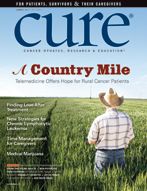Publication
Article
CURE
In the Spotlight: Young-Adult Cancer
Young-adult cancer is grabbing attention as a topic for novels, TV shows and movies.
Photo by © John M. Mantel/Splash News/Corbis

Actors Shailene Woodley (left) and Ansel Elgort played the central roles in the movie “The Fault in Our Stars.” [Photo by © John M. Mantel/Splash News/Corbis]
Is cancer getting trendy?
That was what Hodgkin lymphoma survivor Mallory Casperson wondered after she noticed the huge popularity of The Fault in Our Stars, a 2014 movie that was a love story between two young patients who meet at a cancer support group.
The movie, which earned a solid 8.0 rating out of 10 on the Internet Movie Data Base (IMDB), was based on a popular romantic book, and became a favorite among teens and young adults when it was adapted into a film last year.
Around the same time, two cancer-themed TV programs premiered. Fox introduced Red Band Society, about teenagers who live in a hospital cancer ward. ABC came up with Chasing Life, where an attractive 24-year-old newspaper reporter develops leukemia.
Most recently, the movie Me and Earl and the Dying Girl, in which a high school student befriends a classmate diagnosed with cancer, hit theaters.
Casperson, who was diagnosed at age 24 and was still fighting her own cancer battle when Fault and the TV series came out, was hesitant to see any of them. “I worried that watching the shows would make me feel sad and isolated more than I already was,” she says.
But after overcoming her disease, she finally dipped her toe into the fictionalized cancer world. It made her wonder if the relatively recent wave of books, movies and TV programs with cancer as a central theme weren’t trying to glamorize the malady.
“There’s been a wave of programming where cancer is center stage. It’s not the subplot. And the characters are young. They aren’t older people dying of cancer,” she says.
The new wave of fiction and movies draws on a longer tradition of popular literature about young women and illness, suggests Julie Passanante Elman, an assistant professor at the University of Missouri and the author of Chronic Youth: Disability, Sexuality, and the U.S. Media Cultures of Rehabilitation.
Still, The Fault in our Stars “importantly challenges the idea that the only available roles for sick people are either tragic or as an inspiration for non-sick people,” Elman says. “Fault is sentimental, but its chronically ill characters also counter platitudes and pity with snarkiness.”
Fault’s characters are not exclusively defined by their illness. “The story features two young people with a chronic illness who find one another sexy and exciting,” she says. “Part of what may be attractive (to young women) is that adult characters often tacitly accept the female protagonist’s exploring her sexuality, because her illness might mean a shortened life. In these stories, female sexual exploration occurs without the damaging sexual shaming that commonly happens to girls in American culture.”
Still, if you ask Casperson, the fictionalized representation of cancer was unrealistic in its depiction of what cancer looks like.
“Unless it’s a documentary, it will always be lacking,” she says. “You don’t see puffy cheeks from the continued use of steroids. And characters who lose their hair seem never to stay bald for long.”
Ana Dooley, a 14-year-old student from Kingston, N.Y., knows about losing her hair. During her battle with a rare tumor that resulted in her undergoing a liver transplant, she received chemotherapy and lost her locks. Her hair is now wavy, her mother Jacqueline says, and because of the drugs she takes, Ana’s hair has been growing in white.
That didn’t stop her from loving Fault, both movie and book, Jacqueline says. What Ana didn’t love was how some kids reacted to the characters.
“They were worshipping the characters. They all wanted to be Hazel,” she says. “Ana was almost offended by it.” By contrast, Ana, who actually was dealing with cancer, didn’t engender the same worship her fictional counterpart in Fault did.
While Red Band Society earned reviews rivaling those of Fault on IMDB, Casperson found it perhaps even less realistic.
“Who can run around like that?” she asks, laughing at the actors who seem to have an unbelievable amount of energy for cancer patients. “It was like kids with cancer in a dorm room, it was so unrealistic.”
“It was all so stupid,” Ana said about Red Band. “I couldn’t watch more than a few episodes.”






